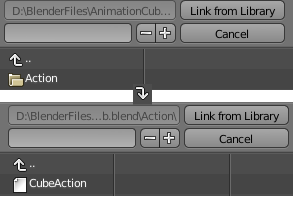Doc:2.6/Manual/Animation/Editors/DopeSheet/Action
Action Editor
Blender 2.5 simplifies the system by making Actions the generic containers for F-Curves. Actions can contain any number of F-Curves, and can be attached to any data block.As long as the RNA data paths stored in the Action's F-Curves can be found on that data block, the animation will work. For example, an action modifying 'X location' and 'Y location' properties can be shared across multiple objects, since both objects have 'X location' and 'Y location' properties beneath them.
The Action Editor window enables you to see and edit the FCurve datablocks you defined as actions in the FCurve Editor window. So it takes place somewhere in-between the low-level FCurves, and the high-level NLA editor. Hence, you do not have to use them for simple Ipo curves animations – and they have not much interest in themselves, so you will mostly use this window when you do NLA animation (they do have a few specific usages on their own, though, like e.g. with the Action constraint, or the pose libraries…).
This is not a mandatory window, as you do can edit the actions used by the NLA directly in the FCurve Editor window (or even the NLA Editor one). However, it gives you a slightly simplified view of your FCurve datablocks (somewhat similar to the “key” mode of the FCurve window, even though more powerful in some ways) – and, more interesting, it can show you all ”action” FCurve datablocks of a same object at once.
Additionally, it also allows you to affect timing of the different keys of the layers created with the grease pencil tool.
Each “action” FCurve datablock forms a top-level channel (see below). Note that an object can have several Constraint (one per animated constraint) and Pose (for armatures, one per animated bone) FCurve datablocks, and hence an action can have several of these channels.
Action Datablocks
As with other things in Blender, actions are datablocks. Unlike the F-Curve ones, there's only one type of action, which can regroup all FCurve of a given object. You’ll find its usual datablock controls in the Action Editor header.
Assigning a “fake user” to the action guarantees you that you won’t lose your precious previously-edited actions when you start working on a new one, upon saving and reopening the file.
This window shows the action datablock linked to the current active object.
Interface
By their functionality, header, menus and window interface of the Action Editor is universal as for whole Dope Sheet Editor and about these you can see more details in corresponding sections:
Using Action Editor
You may set and adjust a same set of animation events in Graph Editor with editing F-curves.
Then, you can to group these action F-curves to single action.
Thereafter, you add constraint Action to the required object or armature and set it to using the yours previously customized action.
And henceforward, you can reuse that action in this way in other scenes and projects.
Working with poses in the Action Editor
Another destination to the Action Editor is a working with poses which are set in Pose mode during the rigging character armature.
For these purposes pose markers are using in the Action Editor, which are detail described in section about animating armatures.


